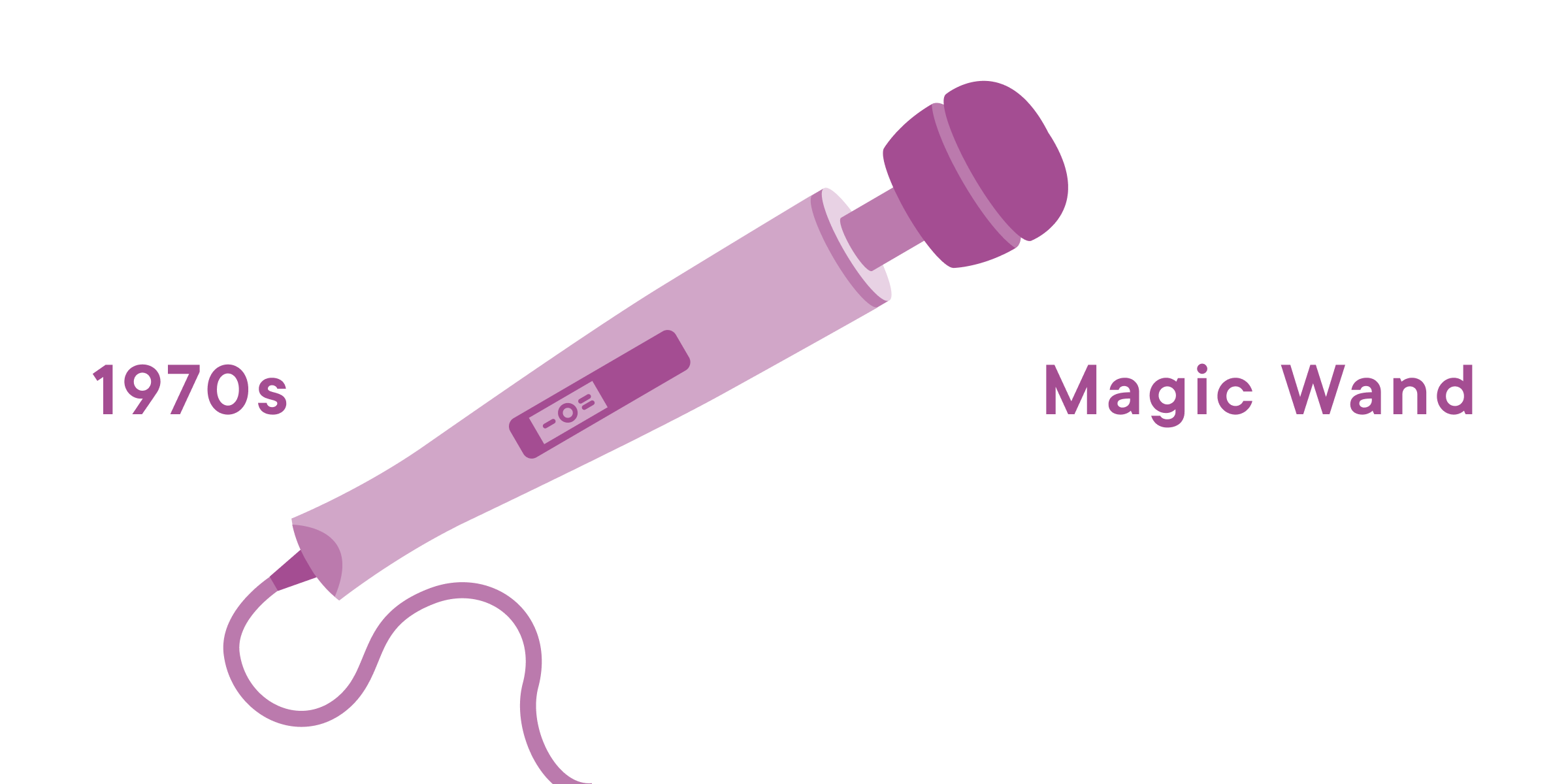Illustrations and animations: Susi Vetter. Scroll animation code: Jesse Pinho
A short history of the vibrator
From bees to bullets.

Vibrators are popular: over 52% of women in the US have used one, and many men use them too (1-3). But where did they come from?
You might have heard the story of how a doctor invented the vibrator as a treatment for hysteria. Sorry to kill your buzz, but that’s not quite how it happened. There’s a lot of myths and misinformation surrounding the history of vibrators in the West, starting with Cleopatra.

Did Cleopatra invent the vibrator? Not quite.
In her 1992 Encyclopedia of Unusual Sex Practices, Brenda Love claimed that Cleopatra (69-30 BC) used a gourd filled with bees to stimulate her genitals, similar to a vibrator (4). This idea has been repeated and reprinted in many popular histories of vibrators. Historian Helen King says that there’s no evidence that this actually happened. Love’s book does not cite any sources, and there are no ancient writings or archeological finds that mention Cleopatra’s supposed invention.
Many links have been made between vibrators and the diagnosis of “hysteria.” The term comes from the Greek hysterika, meaning uterus. During the 6th century BC, a Greek physician named Aretaeus theorized that the womb could move freely around a woman’s body, causing ill physical and mental health (5). Since then, “hysteria” has been used to describe a multitude of ailments, especially in women—from aggression, to fainting, to nymphomania, to farting (6).

1800s: “Manipulators,” “circulators” and the myth of medical masturbation
Jumping ahead a thousand years (and some) brings us to a popular idea in the history of vibrators: that they were invented by western doctors in the 19th century, and used to masturbate hysterical women.
In the 1800s, industrialization transformed many aspects of life, including medicine. English physician Joseph Mortimer Granville invented an electric vibrator in 1883, although similar machines like Dr. George Taylor’s steam-powered “Manipulator” table massager were already in use in France and the US.
If Granville sounds familiar, you probably know him as the sexy doctor from the 2011 film “Hysteria”. Unfortunately the movie—based on Rachel Maines 1998 book, “The Technology of Orgasm”—is somewhat inventive with the facts (7). Maines herself admits,
People just loved my hypothesis and that’s all it is really, it’s a hypothesis, that women were treated with massage for this disease, hysteria… and that the vibrator was invented to treat this disease. Well, people just thought this was such a cool idea that people believe it, that it’s like a fact. And I’m like, ‘It’s a hypothesis! It’s a hypothesis!'
Historian Helen King has found no evidence that doctors ever masturbated their patients as a hysteria treatment in ancient or classical times (6). Hallie Lieberman, author of “Buzz: The Stimulating History of the Sex Toy,” told me that even if it did exist, clitoral massage was not a common medical procedure. After extensive research, Lieberman has never found any proof of a doctor using a vibrator to stimulate a patient’s clitoris to “paroxysm” or orgasm.
So what was Granville’s vibrator for?
It was designed to treat pain, headaches, irritability, indigestion, and constipation—in men.
Lieberman points out that Granville knew the vibrator could have sexual uses, and even used it to treat male sexual dysfunction, but he never used it on women (8).
At this time, hand crank models like Dr. Macaura’s “Pulsocon” were popular, due to their low cost and lack of need for a power source. The Pulsocon was marketed as a Blood Circulator, which could “stop pain quickly and cure chronic sufferers.”
1900s: Vibrators as a cure for male impotence?
Many doctors tried to treat diseases with vibrators, but found them ineffective. In 1915 the American Medical Association took a stand, calling the vibrator industry “a delusion and a snare.” Vibrator makers changed their approach, and started advertising their products as home appliances for men and women of all ages.
Ads ran in popular magazines, Christian publications, and the New York Times, claiming that vibrators could cure everything from wrinkles to malaria.
The devices were sold in department stores and popular mail order catalogs, and Good Housekeeping magazine published a "tried and tested" review of different models (9).
But were people using them to masturbate? Advertisers certainly seemed to be hinting at that. A 1908 advert for the Bebout vibrator assures readers that it was “Invented by a woman who knows a woman's needs” (7). Lieberman says that although many ads used suggestive language, companies didn’t write anything about masturbation in relation to their products.
At this time masturbation was widely viewed as shameful, and “obscene” articles were illegal in the US under the 1873 Comstock Act (10,11). This meant that vibrators could not be openly advertised as sexual products. To avoid prosecution, vibrator manufacturers adopted the strategy used by contraceptive companies: they emphasized the non-sexual uses, and used euphemistic language and imagery to hint at sexual uses of their products (12).
During this era men’s sexuality was more socially acceptable while women’s sexuality was rarely discussed—one reason why vibrators were advertised as a cure for male impotence, but not for sexual use by women (13). Many vibrators came with dildo-like attachments, but these were officially to treat uterine complaints and constipation.
According to Lieberman, “It’s impossible to deny that sexual uses for vibrators weren’t known.”
Doctors did worry about vibrators’ masturbatory potential, but they were usually thinking of men. A 1912 men’s advice book, warned: “Various electric vibrators have been abused by the unscrupulous … to give men vibratory massage of the generative organs … a sensation similar to that of masturbation” (9).
Fern Riddell, a specialist in Victorian sexuality, confirmed, “Victorian doctors knew exactly what the female orgasm was; in fact, it’s one of the reasons they thought masturbation was a bad idea.” They knew about the function of the clitoris, some physicians going so far as to remove them as a “cure” for nymphomania (14). Only one doctor of the era—women’s health advocate Clelia Mosher—actually talked to women about their experiences, confirming that they did masturbate (15). Were they using vibrators to do it? It seems that some of them were.
Gynecologist and sex researcher Robert Latou Dickinson noted that one of his patients had used an electric vibrator to masturbate, but he didn’t make any remark indicating he found this unusual (13). Another doctor, Edwin Hirsch, was concerned about the potential for vibrators’ sexual use by women, warning that “Ostensibly, the treatment is for erosion of the cervix ... but the hidden purpose in innumerable cases is for the masturbatory action and the resulting voluptuous sensations” (16).

1920s-1950s: “That great-to-be-alive feeling”
Alfred Kinsey published groundbreaking research on female sexuality in 1954, including the finding that 62% of the women surveyed had masturbated, though he didn’t mention anything about vibrators (17).
Around this time, the Food & Drug Administration (FDA) began cracking down on vibrators, but not because of associations with masturbation. The FDA had an issue with the marketing of vibrators as cure-alls and weight loss devices, remarking that, “the benefits of vibration are limited to temporary relief of minor physical conditions.” (9)
Electric vibrators such as the The Polar Cub were marketed as superior beauty aids, capable of transforming not only a woman’s face but her entire body. An ad for the Arnold vibrator promised, “Every woman can have a faultless complexion and youthful, finely proportioned figure,” adding, “There is no further need of powder, paint, pads, or other deceptions.”
In 1956 the department store Sears produced their own vibrator, which was advertised as giving you that “great-to-be-alive feeling” (9).

1960s-1970s: Masturbation as liberation
As the birth control pill became widely available and attitudes towards premarital sex relaxed, some people began to speak more positively about masturbation. Sex educator and artist Betty Dodson began teaching women-only masturbation workshops in New York City in the late 1960s. Her original teaching aids were an [Oster](http://www.dodsonandross.com/blogs/betty-dodson/2010/06/having-sex-machines-return-electric-vibrator) and a Panasonic Panabrator, but from the mid 1970s Dodson began recommending the Hitachi Magic Wand, helping to make it one of the most popular and well-known vibrators of all time.
In a 1974 article in Ms. Magazine, Dodson proposed that women masturbate as a way to regain the sexual self-knowledge long denied them by society. How? Use a vibrator:
“I have found that the vibrator gives me the strongest and most consistent form of stimulation and is especially good for women who have never experienced orgasm.”
Dodson wasn’t the only writer extolling the virtue of vibrators: British doctor Alex Comfort enthused about them in ‘The Joy of Sex’ (1972), saying, “They can produce some sexual feeling in almost any woman.”
But masturbation was still stigmatized in the US. A 1974 study found that 61% of women surveyed, masturbated, but 25% of them said they felt guilty, perverted, or feared going insane from doing it. And in some places it was criminal. The “Obscene Device Law” introduced in Texas in 1973, prohibited “any device designed or marketed primarily for the stimulation of human genital organs.”
To get around these laws, companies marketed vibrators as “personal massagers.” This era also saw the opening of the first women-run sex shop in New York, Eve's Garden (18).

1980s-1990s: Masturbation goes mainstream—and, of course, the Rabbit
In 1983 the sex toy company Vibratex became the first to bring vibrators with internal and external components to the US. These toys were produced in bright colors and animal shapes in order to get around obscenity laws in Japan, where the vibrators were made. The Beaver, the Kangaroo, and the Turtle all had an internal, penis-like component, along with different types of ticklers for external stimulation, but it was the Rabbit vibrator that rose to fame, thanks in part to an appearance on “Sex and the City.” The episode, which aired 1998, shows Charlotte becoming addicted to a Rabbit vibrator.
2018: Easier to buy, and more popular than ever, but still taboo
Eve’s Garden was the first of many women- and sex-positive adult stores, and in the US vibrators are now sold at mainstream stores like [CVS and Target](http://usatoday30.usatoday.com/news/health/wellness/story/2012-05-29/vibrators-and-sex-toys-sales/55289424/1). The internet has made it easier for people to buy vibrators without even leaving their homes. There’s even talk about vibrators on daytime TV: on The Oprah Winfrey Show, Dr. Laura Berman recommended that mothers give their teenage daughters vibrators so they can learn about sexual pleasure. But stigma and double-standards persist. In 2010, MTV refused to air a commercial for Trojan’s Vibrating Triphoria unless the word “vibrator” was removed (9). Meanwhile, ads for erectile dysfunction were permitted.
In some places, vibrators are still illegal. In 1998 Alabama legislators passed a law forbidding the sale of any device “designed or marketed as useful primarily for the stimulation of human genital organs,” the penalty a $10,000 fine and one year in jail (19). At least two women have been arrested. The Texas anti-vibrator law from 1973 is still in effect, although in 2008 one judge declared it "unconstitutional and unenforceable.” Outside of the US, there are many other places where vibrators are prohibited, or their legality is unclear, including the Maldives, the United Arab Emirates, Saudi Arabia, Thailand, Malaysia, India, and Vietnam.
Technological innovations abound: from eco-friendly rechargeable vibrators, to high grade medical silicone models offering a variety of speeds, rhythms, and motions. There are pocket-sized “bullet” vibes, hand free options, vibrators which stimulate multiple body parts at once, and upscale “sex jewelry” like the million-dollar gemstone-encrusted Pearl Royal. Smart vibrators can be programmed, remote-controlled, and synchronised to your favorite music.
Culturally, it’s hard to say how much has changed since the vibrator’s invention. Vibrator use is common among heterosexual, lesbian, and bisexual women, and vibrator use is associated with health‐promoting behaviors and positive sexual function (20,21). A wider spectrum of gender and sexuality is acknowledged in film and TV, although we have little information about vibrators’ history as it pertains to folks outside the gender binary.
But vibrators continue to be sold as massagers or novelties, and female masturbation is still often portrayed as shameful, ridiculous, or inferior to sex with a man. In the US, birth control and sex toys for women are still heavily regulated, while men’s sex aids like Viagra are openly promoted.
It would be nice to think that western sexual mores have progressed in a straight line from repressed to liberated, but the history of the vibrator—and attitudes towards it—are constantly in flux.
Edit: June 18, 2018 We received thoughtful feedback from historian Helen King, who told us that the story about Cleopatra and her gourd of bees is not only difficult to verify, but actually a myth. We edited our article to make this more clear.
This article was originally published June 6th, 2018.